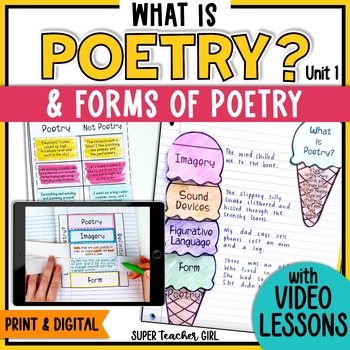Poetry Introduction & Types of Poems Interactive Notebooks, Videos, Lesson Plans
- Zip
- Google Apps™

What educators are saying
Also included in
- This Bundle includes 6 Poetry Units and is packed full of interactive notebook activities, slideshow lessons, video lessons, quizzes, original poems, and hands-on practice activities. This resource has everything you need to make poetry accessible to your students. Print and digital options are inclPrice $31.75Original Price $46.80Save $15.05
- SAVE OVER 30% on this BUNDLE of ALL my POETRY RESOURCES! Plus, get two BONUS FREEBIES! Need engaging poetry activities for your students? This bundle includes interactive video lessons, introductory PowerPoints, original poems, quizzes, puzzles, and various other activities. Google Slides activitiePrice $37.75Original Price $56.05Save $18.30
Description
Do you need engaging activities and done-for-you lessons to introduce your poetry unit? With detailed lesson plans, video lessons, interactive notebook activities, slideshows, writing templates, and hands-on activities, your students will have a clear understanding of poetry. The lesson plans will save you so much time, and the video lessons provide quality instruction so you can work with small groups.
>>>WHAT'S INCLUDED<<<
- 8-Page Detailed Lesson Plans- This unit includes seven complete lessons with engagement ideas, approximate teaching times, explicit steps, and follow-up activities.
- Whole-Class Intro Activity- Includes poems and instructions to launch your poetry unit in a way that will get kids excited and eager to learn more.
- Google Slides Version - This 3-page activity allows students to type their responses on sticky notes next to each example poem.
- Interactive Notebook Activities with Video Lessons: The video lessons walk students through assembling the activities, writing notes, and explaining the concepts.
- What is Poetry Easy-Cut Version- Interactive Notebook with VIDEO Lesson
- What is Poetry Ice Cream Version- Interactive Notebook with Video Lesson
- Forms of Poetry- Interactive Notebook Activity with Video Lesson
- Forms Included- Limerick, Haiku, Free Verse, Cinquain, acrostic, and Quatrain.
- What is Poetry? Introductory PowerPoint & Google Slides™ Lesson- This 50+-page presentation will help you introduce the basics of poetry to your students.
- Video Lesson option that guides students through the PowerPoint independently.
- Student Handout- Kids complete this as they follow along with the lesson.
- Poetry or Not? Student Sort (print & digital)- Students determine if a piece of writing is poetry or not.
- Forms of Poetry PowerPoint & Google Slides™ Activity- This 25+ slideshow is a fun way for students to practice identifying different types of poems.
- Forms of Poetry Puzzles (print & digital)- This is an engaging group activity where students work together to match six forms of poetry with their definitions and examples.
- Poetry Writing Prompts and Templates- Student writing pages are included for each of the six types of poems. The writing prompts will get your students excited to try writing their poems.
*Links to Google Slides™ Activities are included in the PDF download.
++++++CHECK OUT MY OTHER POETRY RESOURCES
Elements of Poetry & Parts of a Poem
What is Poetry and Forms of Poetry
Figurative Language in Songs PowerPoint Game
Pirates of Poetry Mystery Pictures
======Check Out My Other Poetry Videos======
What is Poetry: https://youtu.be/gsUgvczof8M
Parts of a Poem: https://youtu.be/ek35q5S9XD0
Elements of Poetry: https://youtu.be/o7fYAtgy2jo
Poetic Sound Devices: https://youtu.be/uLUCDnpR3iA
Literal & NonlIteral: https://youtu.be/qNC7BTbydrU
Figurative Language: https://youtu.be/gtntVxyfoJU
Imagery: https://youtu.be/AfNknMB9hm0
Forms of Poetry: https://youtu.be/ihAmTnCbnxY
Subscribe to my YouTube channel for more educational videos!
If you enjoy this product, please leave feedback and follow me for updates on new resources and freebies!
*Please make sure you have Adobe Reader, PowerPoint & a Google account to view these documents.







